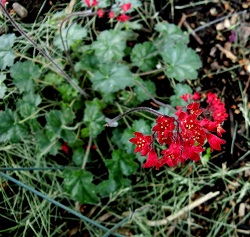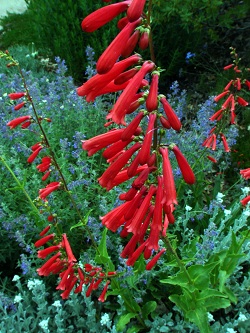Gardening for Hummingbirds
Courtesy & © Jim Cane, Photographer
 Penstemon eatonii
Penstemon eatonii
Courtesy & © Jim Cane, Photographer
Hummingbirds visit flowers for their nectar which fuels their flight. Their long tongue reaches well beyond the tip of their needle like bill when they lap up nectar; capillary action then draws the sweet liquid up tiny grooves along the length of the tongue.
Floral nectar evolved to attract potential pollinators. The floral nectary is generally found inside the flower, at the base. When probing for nectar, floral visitors brush by the reproductive structures. Pollen adheres to parts of their body and then at the next flower of the same species, some pollen sticks to the female stigma. This transfer is pollination.
Many nectar-rich flowers grow well in Utah gardens. In the xeric garden, Penstemons are a good choice, as are Red Hot Pokers and Zauschneria, sometimes called Hummingbird Trumpet. In more moist sites, red flowered Heuchera is popular. Some red flowered cacti and Trumpet Creeper are good choices, as are Agastache and many Salvias.
Watch which flowers hummers visit. They will check out many blooms, but the ones they routinely return to are the ones yielding generous nectar. Many flowers produce little or no nectar, including some that look to us like good hummingbird flowers. Also, many horticultural hybrids and doubled flowers produce paltry amounts of nectar.
To encourage hummingbirds to remain in your garden, you can grow trees and shrubs for cover. Nectar is only part of their diet. For protein, they regularly eat insects and spiders small enough for their tiny bill so a garden free of insects is not desirable. They also appreciate a place to perch where they can digest, wait for a tasty insect to fly by and keep an eye out for potential rivals. So grab your trowel and lets feed those hummers.(Kevin Cover: Songbirds of Rocky Mountain Foothills. Broad-tailed Hummingbird)
This is Linda Kervin for Bridgerland Audubon Society.
Credits:
Images: Courtesy and Copyright Jim Cane, Photographer
Theme: Courtesy & Copyright Don Anderson as performed by Leaping Lulu
Text & Voice: Linda Kervin, Bridgerland Audubon Society
Additional Reading:
Linda Kervin’s pieces on Wild About Utah
Hummingbirds and How to Attract Them, Washington Department of Fish & Wildlife, https://wdfw.wa.gov/living/hummingbirds/
Hummingbirds 101, The Hummingbird Society, https://www.hummingbirdsociety.org/hummingbirds-101/
Coro Arizmendi Arriaga, Maria del, Hummingbirds of
Mexico and North America, In Spanish and English, CONABIO, 2014, https://www.biodiversidad.gob.mx/Difusion/pdf/colibries_mexico_y_norteamerica.pdf
Gardening for Hummingbirds
Gardening for Hummingbirds
Gardening for Hummingbirds
